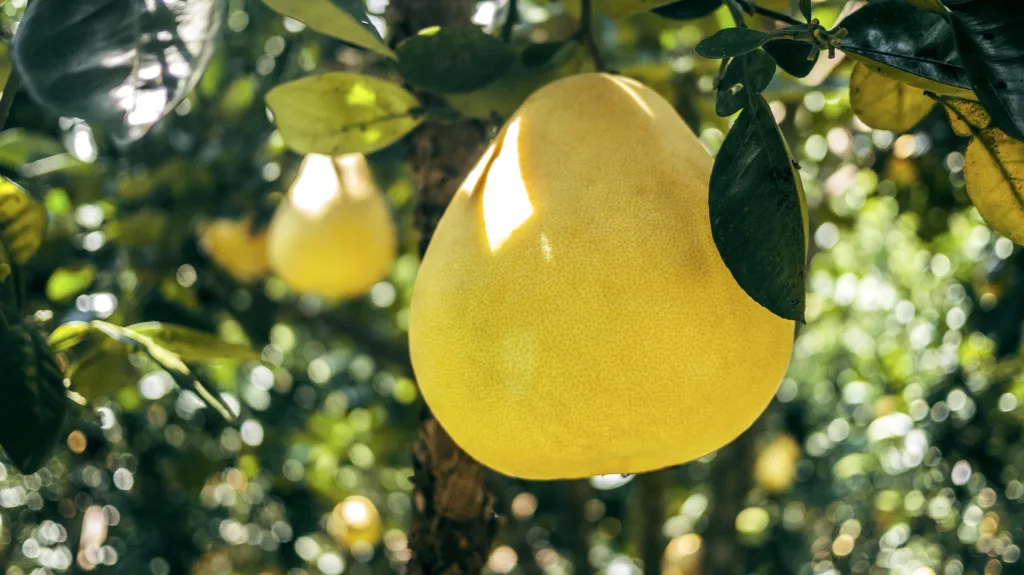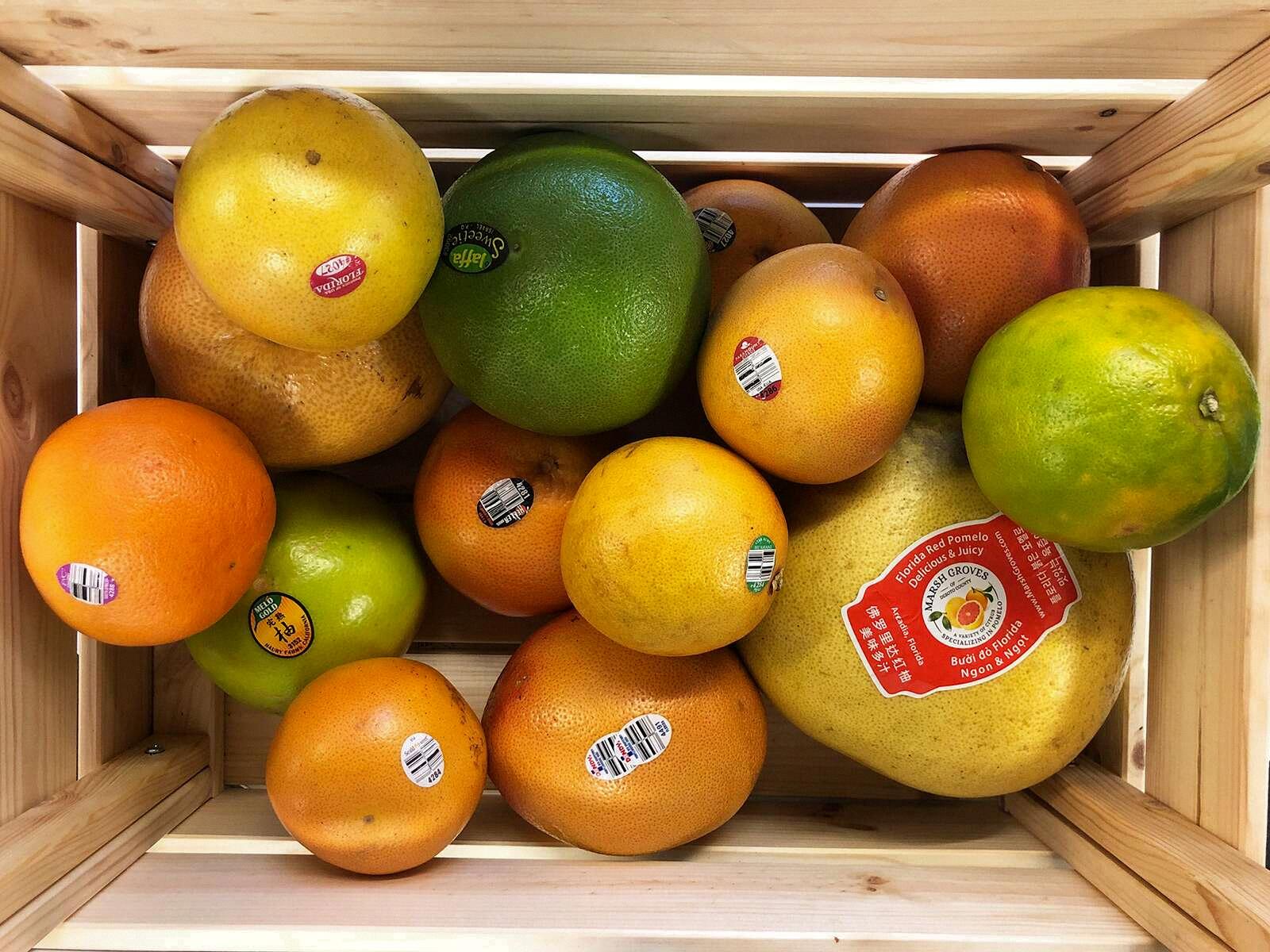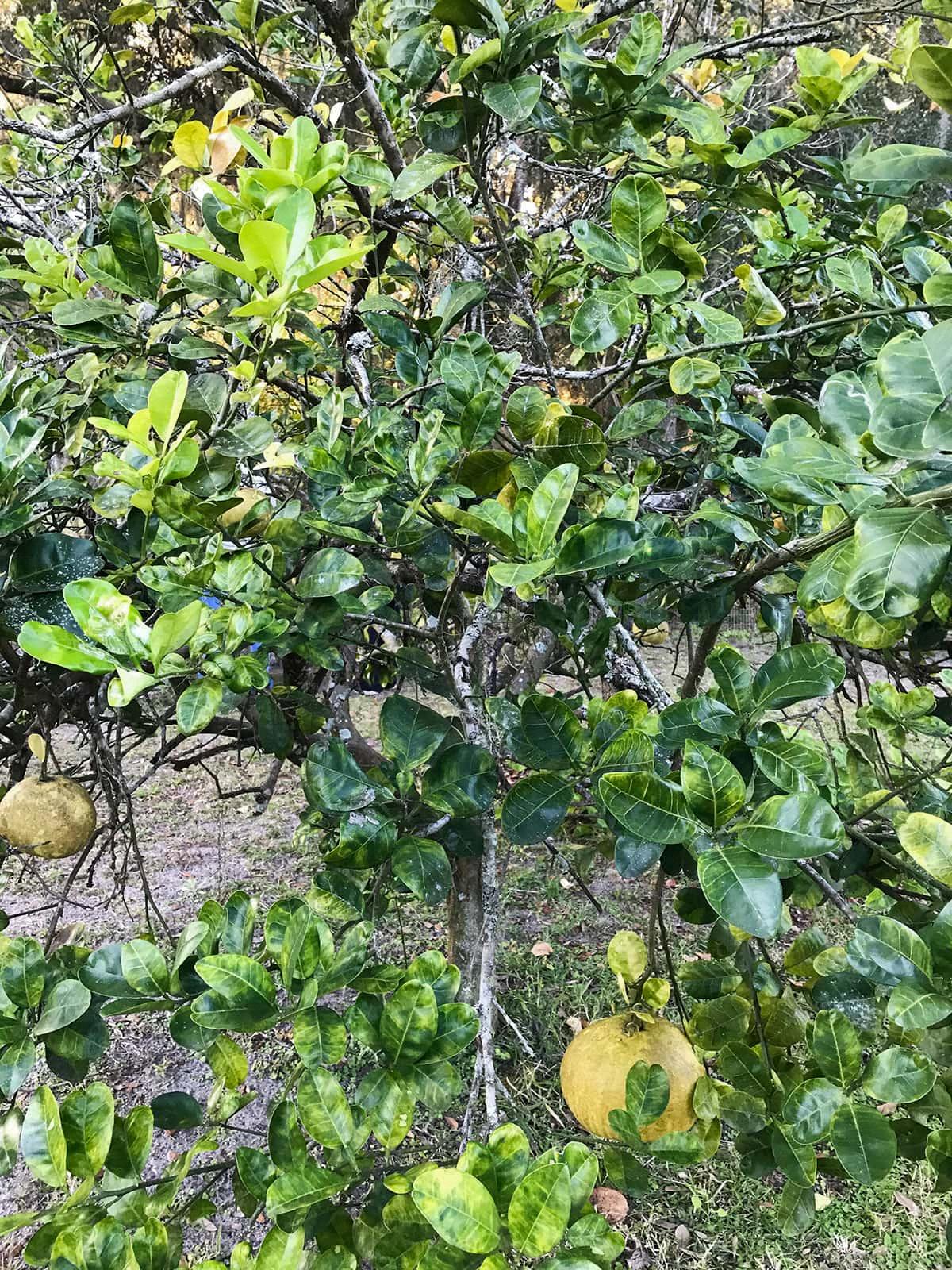Have you ever heard of the Florida pomelo? This large citrus fruit is native to Southeast Asia and is now grown in many parts of the world, including Florida. It is a close relative of the grapefruit, but with a sweeter taste and thicker rind.
The Florida pomelo is a popular fruit in Asian cuisine, where it is used in salads, desserts, and beverages. It is also becoming increasingly popular in the United States, where it is enjoyed as a healthy snack or ingredient in recipes.
The Florida pomelo is a large fruit, typically measuring 5 to 12 inches in diameter and weighing 2 to 5 pounds. It has a thick rind that can range in color from green to yellow, depending on the ripeness of the fruit. The pulp can be white or pink, with a sweet to acid flavor that is similar to that of a grapefruit, but less bitter.
The pomelo’s thick rind is not just for appearance, it actually serves a purpose. The rind helps to protect the fruit from insects and other pests, and also helps to keep the fruit fresh for longer periods of time.
The Florida pomelo is not only delicious, it is also packed with nutrients. It is a good source of vitamin C, potassium, and fiber. Vitamin C is an antioxidant that helps to boost the immune system, wile potassium is important for maintaining healthy blood pressure. Fiber is essential for digestive health and can help to lower cholesterol levels.
The Florida pomelo can be eaten in a variety of ways. It can be peeled and eaten like an orange, or sliced and added to fruit salads. Some people like to sprinkle sugar on the fruit to enhance its sweetness.
Florida pomelo can also be used in recipes, such as pomelo salad, which is a popular dish in Southeast Asia. The salad typically includes pomelo segments, shrimp, cilantro, and a sweet and sour dressing.
Florida pomelo is grown in many parts of the state, including Miami-Dade County, which is known for its citrus production. The fruit is typically in season from November through March, and can be found at farmers markets and specialty grocery stores.
The Florida pomelo is a delicious and nutritious fruit that is worth trying. With its sweet taste and nutritional benefits, it is a great addition to any diet. So, next time you’re in the produce section, look for the Florida pomelo and give it a try!
Are Pomelo and Grapefruit the Same?
Pomelos are not the same as grapefruit. Although they are both members of the citrus family, they are different species. Pomelos have a thicker rind than grapefruit and contain much more pith. Additionally, pomelos are generally shaped more like a pear or teardrop, while grapefruit are typically round. Furthermore, the grapefruit is actually a hybrid resulting from crossing a sweet orange with a pomelo, making it genetically distinct from its pomelo counterpart. Therefore, while they may share some similarities, pomelos and grapefruit are not the same fruit.

Average Size of a Florida Pomelo
A Florida pomelo typically measures between 5 to 12 inches in diameter and weighs around 2 to 5 pounds. The size may vary depending on the maturity and growing conditions of the fruit. The pulp of a pomelo can be found in different colors such as white, pink, pale yellow or reddish, and has a sweet to acid taste, depending on the variety. the Florida pomelo is a substantial citrus fruit with a unique flavor profile that makes it a favorite among fruit lovers.
Tasting a Pomelo: What to Expect
If you are wondering what a pomelo tastes like, the answer is that it is very similar to a grapefruit. Pomelos are citrus fruits that are slightly larger than grapefruits and have a thicker, spongy rind. The flesh of a pomelo is typically pale yellow or pink and divided into segments like other citrus fruits.
In terms of taste, most pomelo varieties have a sweet and slightly tart flavor, with a hint of bitterness. Some pomelo varieties have a more delicate, floral taste than grapefruits, whch is prized by growers and consumers alike. Honey pomelos, for instance, have a light yellow skin and flesh and a mild flavor.
If you enjoy the taste of grapefruits, you are likely to enjoy the taste of pomelos as well. However, if you find grapefruits too tart or bitter, you may not enjoy the taste of pomelos as much. It is always recommended to try a small amount of a new fruit before consuming it in large quantities to see if you enjoy the taste.
Side Effects of Eating Pomelo
Pomelo is a nutritious fruit that is loaded with vitamins and minerals. However, overeating pomelo can lead to certain side effects. One of the most common side effects of consuming too much pomelo is an upset stomach. This is because pomelo is acidic in nature and can case an increase in stomach acid levels, leading to discomfort and bloating. Additionally, if you suffer from kidney or liver conditions, you should exercise caution when consuming pomelo as it can cause a buildup of certain minerals in the body. In rare cases, some people may also experience an allergic reaction to pomelo, which can cause symptoms such as itching, hives, and difficulty breathing. It is important to consume pomelo in moderation and to consult a healthcare professional if you experience any adverse effects after consuming it.

Source: myrecipes.com
The Health Benefits of Eating Pomelo
Eating pomelo is very good for you! Pomelo is a nutrient-dense fruit that is packed with several health benefits. One of the most notable benefits of pomelo is its high vitamin C content, which makes it a powerful antioxidant and immune system booster. Just one pomelo fruit can provide several days’ worth of the recommended daily intake of vitamin C.
In addition to vitamin C, pomelo is also rich in other essential vitamins and minerals, including copper, fiber, and potassium. Copper is necessary for the production of red blood cells and helps to maintain healthy bones, while fiber is important for digestive health and can help to lower cholesterol levels. Potassium is essential for maintaining healthy blood pressure levels and can also help to reduce the risk of stroke and heart disease.
Furthermore, the antioxidants found in pomelo can help to protect against cell damage and reduce the risk of chronic diseases, such as cancer and heart disease. Pomelo also conains compounds that have been shown to have anti-inflammatory properties, which can help to reduce inflammation in the body and potentially reduce the risk of chronic diseases.
Adding pomelo to your diet can be an excellent way to improve your overall health and wellbeing.
How to Enjoy Eating a Pomelo
The best way to eat a pomelo is to first remove the thick rind and then peel the membrane from aroud each segment. You can make scoring the rind easier by making shallow cuts around the fruit. It is important to note that you do not eat the membrane, as it can be tough and bitter. Once the segments are exposed, you can enjoy the juicy flesh inside. Pomelos are versatile and can be used in a variety of ways, including in salsas, salads, marinades, and even juiced or made into jam. However, they are also delicious when eaten fresh and right out of your hand.
The Best Country for Pomelo Production
It is difficult to determine which country has the best pomelo as the taste and quality can vary depending on factors such as climate, soil, and cultivation techniques. However, China is known to be the largest producer of pomelo and is highly regarded for its pomelo varieties. Thai pomelos are also highly sought after for their exceptional taste and quality. In fact, Thailand is among the top ten pomelo exporting countries in the world. Ultimately, the best pomelo can be subjective and dependent on personal preference. It is recommended to try pomelos from diffeent countries and regions to determine which one suits your taste buds the best.
The Sweetest Variety of Pomelo
The sweetest pomelo is widely regarded as the Tahitian variety. This pomelo has a vibrant yellow rind and yellow flesh, similar in appearance to a lemon, but its flavor profile is distinctly sweeter. In fact, many people consider Tahitian pomelos to be the sweetest of all pomelo varieties. The fruit has a juicy, refreshing taste that is both sweet and slightly tart, with a delicate floral aroma. Its sweetness makes it a popular choice for eating fresh or juicing, and it’s also a great addition to salads or used in cooking. if you’re lookig for a pomelo with a sweet taste, the Tahitian variety is definitely one to try.

Source: healthiersteps.com
The Effects of Pomelos on Blood Pressure
Pomelos have been found to have a positive effect on blood pressure. Pomelos are a rich source of potassium, which is an essential mineral that helps to regulate blood pressure. Potassium helps to lower blood pressure by counteracting the effects of sodium, which can cause blood vessels to constrict and increase blood pressure. In addition, pomelos are also a good source of flavonoids, which are plant compounds that have been shown to have a beneficial effect on blood pressure. The flavonoids in pomelos help to dilate blood vessels, improving blood flow and reducing blood pressure. Therefore, including pomelos in your diet can be a natural and healthy way to help manage blood pressure levels. However, it is important to note that pomelos should not be used as a replacement for prescribed blood pressure medication, and people with existing medical conditions should consult with teir healthcare provider before making any significant dietary changes.
What is the Hawaiian Name for the Pomelo Fruit?
Hawaiians refer to pomelo as Jabong fruit. This aromatic citrus fruit is also known by other names such as shaddock, pummelo, and Chinese grapefruit. The fruit is native to Southeast Asia and is widely cultivated in tropical regions around the world. It is in season from fall to spring and is highly valued for its sweet and tangy flavor, as well as its numerous health benefits. In Hawaii, Jabong fruit is commonly used in traditional dishes and is a popular ingredient in salads, desserts, and juices.
Benefits of Pomelo for Diabetics
Pomelo can be good for diabetics when consumed in moderation. Pomelo has a low glycemic index (GI), which means it doesn’t cause a rapid increase in blood sugar levels. Additionally, research has shown that the high GI pomelo can serve as a low glycemic load (GL) fruit if consumed with a limited daily amount. This makes it a good food choice for individuals with type 2 diabetes. However, it’s important to note that portion control is key, as consuming too much pomelo can still lead to a spike in blood sugar levels. As with any dietary changes, it’s recommended to speak with a healthcare professional befoe making any significant changes to your diet.
The Edibility of Pomelo Peel
The peel of a pomelo can be eaten. However, it is important to note that the peel can be quite thick and tough, so it may not be to everyone’s liking. Additionally, the white pithy layer just beneath the peel can be bitter, so some people may prefer to remove it before consuming the peel.
That being said, tere are several ways to enjoy the peel of a pomelo. One common method is to candy the peel by boiling it in sugar syrup until it becomes tender and translucent. Candied pomelo peel can be used as a garnish, added to baked goods, or eaten as a sweet snack.
Another option is to use the peel to make marmalade. The zest of the pomelo can be grated and combined with sugar and water to make a tangy and aromatic spread.
In some cultures, the peel is also used in salads and drinks. Thinly sliced pomelo peel can add a bright and refreshing flavor to salads, while a few strips of peel steeped in hot water can make a fragrant and soothing tea.
While the peel of a pomelo may not be as commonly consumed as the fruit itself, it can be a versatile and flavorful ingredient in a variety of dishes and preparations.

Identifying a Ripe Pomelo
To determine if a pomelo is ripe, there are a few key indicators to look out for. Firstly, the skin of the fruit should be thick, dull and pale green to yellow in colour. If the skin is shiny and green, it is likely that the fruit is not ripe.
Secondly, the shape of the fruit can also be an indicator of ripeness. A ripe pomelo is typically round to pear-shaped. If the fruit is misshapen or uneven, it may not be fully ripe.
Lastly, the flesh of a ripe pomelo should be white in colour. If the flesh is pink or red, the fruit may be overripe. It is also important to note that a ripe pomelo should feel heavy for its size and have a sweet fragrance.
By taking note of thse key indicators, you can ensure that you select a ripe and delicious pomelo for your consumption.
The Sourness of Pomelo Fruit
Pomelo is a citrus fruit that is known for its distinctive sour taste. This sourness is due to the presence of organic acids, particularly citric acid. Citric acid is a natural compound found in many citrus fruits and is responsible for ther acidic taste. In pomelos, the level of citric acid is particularly high, which gives the fruit its characteristic sourness.
In addition to citric acid, pomelo also contains other organic acids such as malic acid and tartaric acid, which contribute to its sour taste. These acids also give pomelo its refreshing and tangy flavor.
It is worth noting that the degree of sourness in pomelo can vary depending on various factors such as the ripeness of the fruit, the growing conditions, and the cultivar. Some pomelo varieties may be sweeter than others, but the sour taste is still a defining characteristic of the fruit.
The sourness of pomelo is due to the presence of organic acids, particularly citric acid, which gives the fruit its distinctive taste and flavor.
Conclusion
The Florida pomelo is a delicious and unique citrus fruit that has a lot to offer. With its thick rind, large size, and sweet to acid flavor, it is a popular choice for many citrus lovers. While it has some similarities to the grapefruit, it also has its own distinct qualities that set it apart. Whether you’re looking for a new and exciting ingredient for your recipes, or simply enjoy tryig new fruits, the Florida pomelo is definitely worth a try. So why not head to your local farmers market or grocery store and pick up a pomelo today? You won’t be disappointed!
